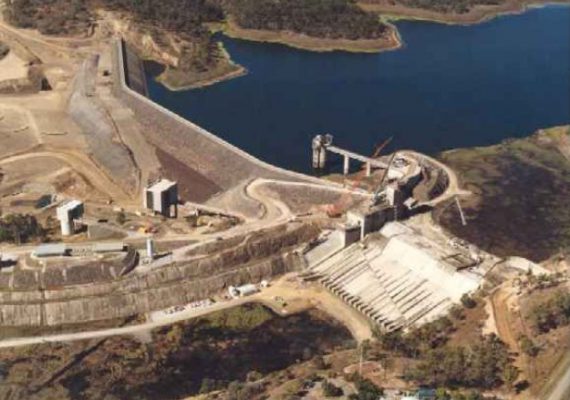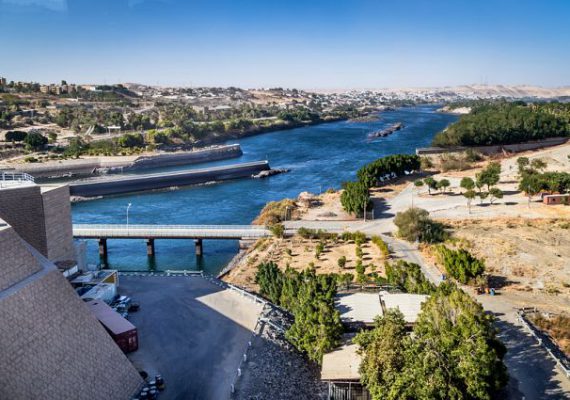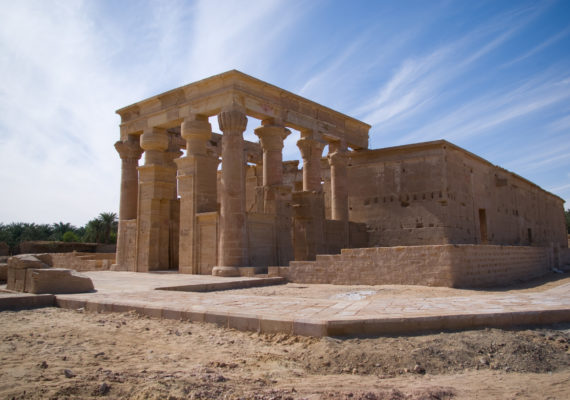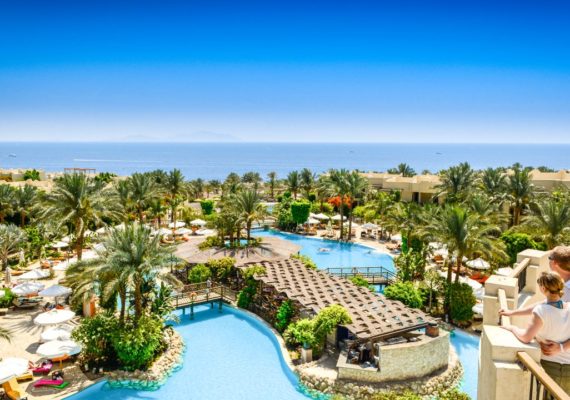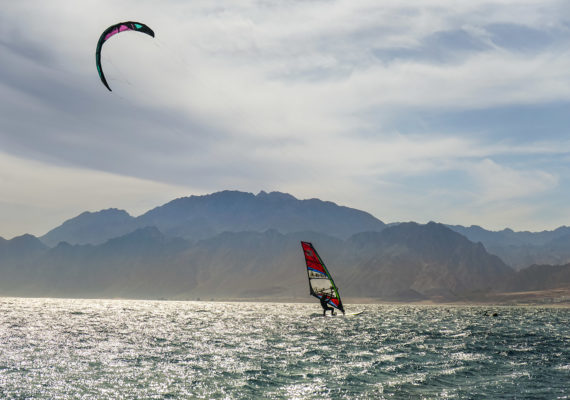The Nile had to be controlled if there was to be agricultural stability along its banks. Harnessing the power of the Nile would also yield hydroelectric power necessary for industries. To the increasingly industrial societies of the region, the choice was clear.
In 1899, construction of the first Aswan Dam was begun. Completed in 1902, its height was raised in subsequent building campaigns of 1907-12 and 1929-34. Even with these renovations, the first, or “Low,” dam proved to have an inadequate reservoir area. In the event of extreme flooding, it would be necessary to open the sluices of the dam to relieve the water pressure against it, flooding the areas thought to be protected.
A second dam was necessary at Aswan, and in the early 1950s, designs began to be drawn for what was to become the High Dam as Aswan. With the signing of the Nile Water Agreement by Egypt and Sudan in November of 1959, work began on the second Aswan dam. The British began construction of the first dam in 1899 and it was completed in 1902. The project was designed by Sir Wiliam Willcocks and involved several eminent engineers
including Sir Benjamin Baker and Sir John Arid, whose firm, John Aird & Company, was the main contractor. A gravity dam, it was 1,900 m long and 54 m high. The initial design was soon found to be inadequate and the height of the dam was raised in two phases, 1907–1912 and 1929–1933
When the dam almost overflowed in 1946 it was decided that rather than raise the dam a third time, a second dam would be built 6 km up-river(about 4 miles). Proper planning began in 1952, just after the Nasser revolution, and at first, the US and Britain were to help finance construction with a loan of USD$ 270 million. Both nations canceled the offer in July 1956 for reasons not entirely known. A secret Egyptian arms agreement with the USSR and Egyptian recognition of the People’s Republic of China are cited as possible reasons. Soon thereafter, Nasser nationalized the Suze Canal, intending to use its tools to subsidize the High Dam project.
The building of the High Dam at Aswan would have grave implications. Much of Lower Nubia would be submerged under the reservoir created by the dam, destroying monuments and archaeological sites from the First to the Third Cataracts of the Nile River. Ambitious rescue operations were begun in 1960 after an appeal was issued by Vittorino Veronese, the then Director-General of UNESCO. (United Nations Educational, Scientific, and Cultural Organization) Three stages of operations were necessary: a survey of the area, excavation of archaeological sites, and the final movement of as many endangered monuments as was possible.
Twenty monuments from the Egyptian part of Nubia and four monuments from Sudan were dismantled, relocated and re-erected. Many others were identified during the survey and were documented before their subsequent inundation. Special permits were issued by the Egyptian and Sudanese governments for archaeological excavations conducted by multinational teams of researchers, including those from the University of Pennsylvania.
In the end, however, time ran out. It became clear that it would not be possible to document many of the sites of Lower Nubia completely, and that much of the information in which careful archaeological excavation can yield would be lost forever.
The Aswan Dams
The Aswan High Dam was designed to control the Nile River. The huge dam controls flooding and stores water for times of drought, it is equipped to provide hydroelectric power. These benefits, however, do not come without a price tag. Engineers and governments must carefully weigh the benefits and the cost of any new technology. Huge environmental projects such as dams must entail even more thought and consideration than a new car engine or a faster microprocessor.
The first [old ] Dam having been built in 1889. At the time Egypt was controlled by the British and they were interested in increased irrigation capabilities for cash crops, such as cotton. Due to the irregular flooding pattern of the Nile river and increased water demands, the dam had to be raised on 2 occasions (1912 and 1933) in order to ensure its continued usefulness and safety. When debates began again over raising the dam a third time, suggestions were made to possibly build a new super dam.
It wasn’t until Egypt experience a revolution in 1952 that the political climate allowed the feasibility of a new dam to be properly studied. The new dam, the Aswan High Dam, was a technical marvel, being “5 kilometers long at its crest, and 1 kilometer thick at its base, and rises 107 meters above sea level.” With the dam’s hydroelectric capabilities, the Egyptian government strives to obtain the maximum benefits available from every gallon of water that flows down the Nile.
And, while most people would agree the flood control and the electricity the dam provides helps economic growth, the cost of these benefits must also be examined. When the Aswan Dam was built, the country of Nubia was flooded. The Egyptian government made arrangements for the Nubians to be relocated, but their lifestyle was destroyed. In fact, many of the nomadic tribes in the area were not warned of the changes that would be happening to the river, which affected their routines in caring for their livestock. Prior to the appearance of Lake Nasser, as the northern part of the reservoir created by the dam is known, the Nubians cultivated plots along the shore. Those areas are now completely underwater. Many people have left the settlements that were created for them and returned to the lake’s edge, trying to recreate their lost culture.
Aswan High Dam
Location
The Aswan High Dam is found at Aswan in Egypt. Egypt is on the continent of Africa. The dam is located 4 miles south of the old Aswan Dam.
Facts
The Aswan High Dam is 3600 meters long and 111 meters high.
The Soviet Union helped the Egyptian government to build the dam.
The Aswan High Dam has 12 turbines that generate over 10 billion kilowatts of electricity every year.
Construction started on the dam in 1960 and it was completed in 1971.
The Aswan High Dam took 11 years to build.
30 000 Egyptian people worked day and night to build the Aswan High Dam.
Lake Nasser was created behind the Aswan High Dam. It is the largest artificial lake in the World (310 miles in length). It is named after Gamal Abdul Nasser, the former President of Egypt.
Advantages of the Aswan High Dam
1) The dam has meant that there is plenty of fresh and clean drinking water for the people of Egypt. They get their drinking water from Lake Nasser.
2) The Aswan Dam is also a hydroelectric power station; it has 12 turbines or engines, which produce 10 billion kilowatts of electricity every year.
The water from the river Nile turns the turbines and makes electricity. The electricity is taken from the dam by cables and is used in factories and homes all over Egypt. People use electricity for cooking, lighting, watching television and many other activities.
3) Water from Lake Nasser is pumped into people’s homes all over Egypt and is used for washing, drinking and washing machines.
4) Factories also use the water for cooling and for making things.
5) Bigger boats can now travel down the River Nile. These boats carry cargo and people who are on cruises. The Aswan High Dam has made the River Nile more navigable. Navigable means that boats can use the river.
6) The Aswan High Dam keeps the depth of the water in the Nile at the same level throughout the year. There are gates in the dam. If the river level is low, more gates can be opened to let more water from Lake Nasser into the river Nile. If the river level is high, then some of the gates can be shut so that the water level can return to normal.
7) Farmers use water from the River Nile to irrigate their crops. Before the Aswan dams were built, the River Nile used to flood every year. No-one knew exactly when the flood would occur. Now, the Egyptian government can flood the land when they need to.
Disadvantages of the Aswan High Dam
1) The land of Nubia had to be flooded to create the reservoir, which is 310 miles
in length. Religious buildings, homes, and cemeteries have been lost. They were photographed before the land was flooded.
2) 10 000 people had to move from their homes in Nubia to other places in Egypt. Some of the people did not want to move house.
3) Sometimes the Aswan High Dam gets blocked by silt and mud. It has to be cleaned, which is expensive. The blocked silt and mud can also create diseases in Lake Nasser. If people drank this water they would become ill. The water has to be cleaned before it is suitable to drink.
4) The temples of Abu Simbel had to be moved. This took a long time, as each stone had to be removed individually.
5) Some of the water from Lake Nasser is lost every year (about 15%). This is because some leaks through the dam and the rest are lost by evaporation. This is a waste of water.
6) The Nile delta is becoming smaller. This is because the Nile no longer carries any sediment and pebbles downstream from the dam. The pebbles and sediment get stuck behind the dam. Wildlife is losing its home because the delta is shrinking in size.
The Nile Fact
Continent: Africa
Countries it flows through Egypt, Ethiopia, Sudan, Burundi
Length: 6670 kilometers
Number of tributaries: 02
Source: Burundi, Central Africa
Mouth: Egypt into the Mediterranean Sea
**When you are in Aswan do NOT miss this overday visit.

